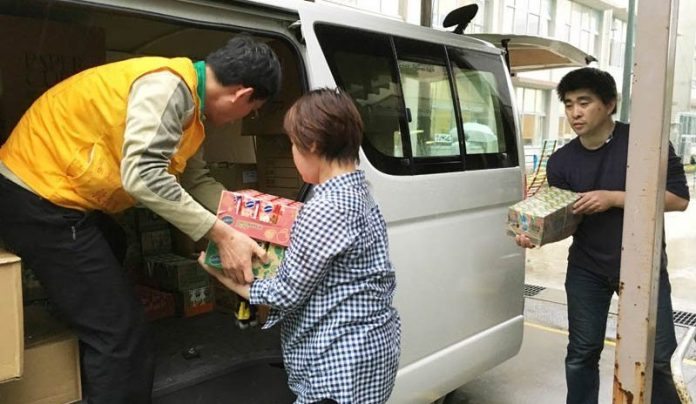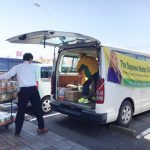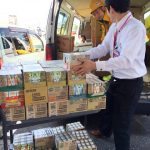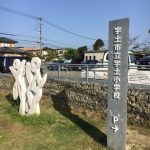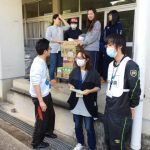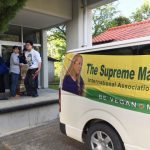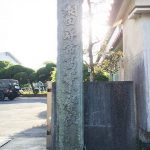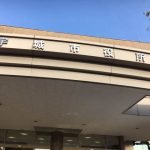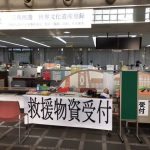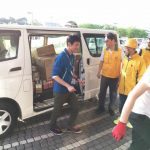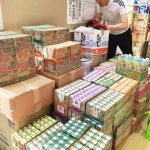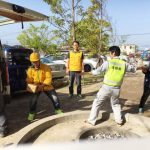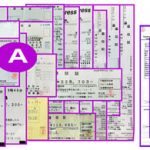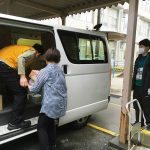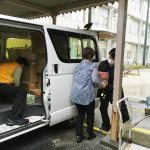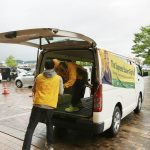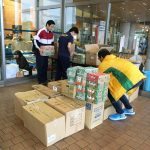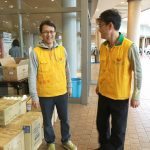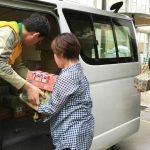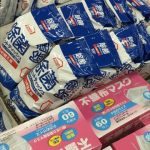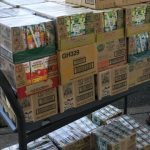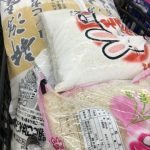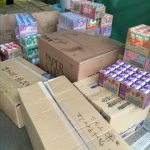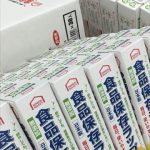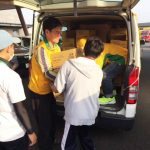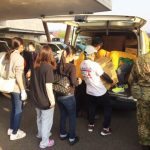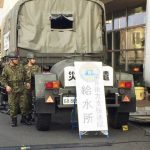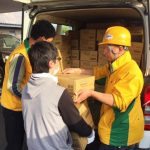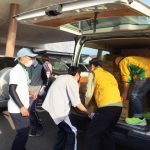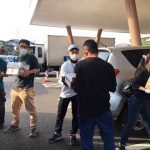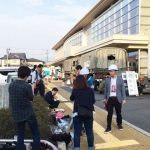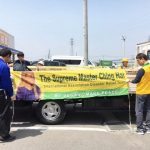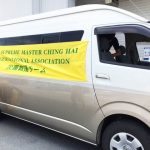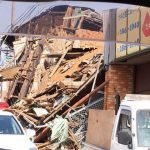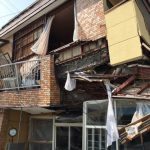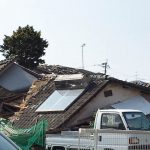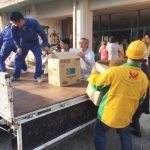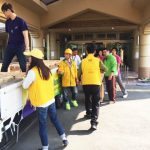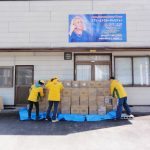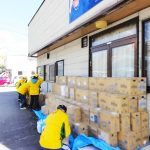By Japan Relief Team (Originally in Japanese)
In mid-April 2016, a series of powerful earthquakes rocked Kumamoto Prefecture in Kyushu Island, Japan. The main tremor of 7.3-magnitude took place on April 16, which was preceded by a 6.5 magnitude earthquake two days earlier and followed by more than 140 aftershocks. As a result, 49 lives were lost, over 2,900 people were injured, and 90,000 were evacuated. The city of Kumamoto was left without water, transportation was disrupted, roads became impassable due to landslides, and numerous structures collapsed or caught on fire. Fearing more aftershocks, some people refused to stay in evacuation centers and opted to live in their own cars.
Keeping in mind Supreme Master Ching Hai’s loving reminder to help our neighbors when they are in need, our Association members from Formosa, and Gunma and Tokyo, Japan quickly formed relief teams and provided emergency aid from April 17 to 22 with US$14,000 contributed by Master and US$7,786.32 from our Japan and Formosa Association members.
Formosa and Tokyo, Japan Relief Team Efforts – April 19 to 22, 2016
Our Formosa and Tokyo, Japan relief team rented a van and a truck in the city of Fukuoka on Kyushu Island and purchased various daily necessities for the affected people, such as vinyl sheets, wet towelettes, paper cups, batteries, rice, beverages etc.
On the morning of April 19, our team drove the loaded vehicles for 3.5 hours and arrived at the town of Mifune in the Kamimashiki District, one of the disaster areas. We distributed the prepared items to the 300 people staying in Takagi Elementary School, which was turned into an evacuation center, and to the 150 displaced elderly people in the Greenhill Mifune Nursing Home. In the evening, our team returned to the city of Fukuoka to refuel and replenish our supplies. The next day, April 20, we bought more goods in the morning and drove back to the Kamimashiki District and delivered the supplies to the Mashiki Health and Welfare Center, which housed 600 people.
According to national TV news, most of the displaced people had enough to eat to survive. However, some remote areas seemed to have inadequate supplies. Also, a few makeshift centers were created by people who were unable to travel to the public supply centers. Moreover, even the well-stocked centers were in need of items. Thus, our relief team worked to bring the supplies required.
An Association member from one of the worst-hit areas, Kumamoto, the capital city of Kumamoto Prefecture, joined our team. She had driven to different facilities and made a list of goods we should bring in the following days. On April 21, we visited Kengun Elementary School and Kasuga Elementary School in the city, which were housing 1,000 and 200 evacuees, respectively. We also visited Aqua Dome Kumamoto, which housed 300 people during the day and 600 at night. Among the goods we delivered were juice, chop sticks, plastic bags, wet towelettes, towels, hygiene supplies, nursing pads for breastfeeding mothers, baby food, toothbrushes, toothpaste, soup bowls, etc. There was an adequate supply of cooked rice, bread and water.
Our relief team was extremely grateful to the kind, cheerful elderly woman in Fukuoka who opened up her home for us to stay. We appreciated the delicious vegan food that was waiting for us during late nights and breakfasts in the morning before leaving for relief work.
As of April 22, the airports and most local trains on Kyushu Island were in operation again and the transportation companies resumed accepting shipments of goods to the disaster areas. Some of the hardest-hit places began openly soliciting volunteers from the outside. After a heavy rain fall the day before that claimed several more lives due to a mudslide, some towns ordered mandatory evacuation to those living at the foothills of mountains, sending the number of displaced people to as high as 210,000.
On April 22, our relief team traveled to and distributed more much-needed food and supplies in the cities of Uto and Uki in the Kumamoto Prefecture. The traffic was even slower than before, so we spent long hours on the road to get to the destinations. In Uto, we delivered goods to two elementary schools, which were turned into evacuation sites to house a total of 800 displaced people. While in Uki, we went to the City Hall, which was housing 1,000 people.
Our team found that the services at the different sites varied significantly from one place to another and the evacuees seemed to be extremely fatigued after living in the cramped living quarters for many days. Doctors and nurses were taking steps to keep the sites hygienic. There was a shortage of caregivers to assist the citizens living with a disability and elderly citizens.
Fortunately, the local governments started a national campaign to get more volunteers and the results were very encouraging. Some cities set up living quarters for newly arriving volunteers so that they could live and work close to the disaster area.
With the danger of landslides receding, the governments also put together plans and funds for building more individual homes that are equipped with basic facilities, knowing that people could not continue living in the temporary shelters. The Prime Minister visited the worst-hit areas and promised quick funding for recovery projects including housing for the thousands of displaced people.
Gunma, Japan Relief Team Efforts – April 17 to 22, 2016
Immediately after the quakes, our Association members from the Gunma Center collected information about the disaster. Then, on April 17, we packed relief supplies: drinking water and moist towelettes.
We soon learned that many roads leading to Kumamoto had been destroyed by the quakes, making delivery of the items almost impossible. We estimated that it would take us at least a week to reach the disaster areas. However, on April 18, we were informed by a local shipping company that a few sections of the roads had miraculously become open. Meanwhile, more requests for warm jackets and undergarments came from shelters in the area. Although Kumamoto is located in a relatively warm region, the temperature drops at night, making life especially difficult for seniors.
As we had already prepared a large supply of the requested items, we quickly purchased more undergarments, including those for children, all of which we packaged in individual bags. Due to our training in charity work under Supreme Master Ching Hai’s guidance, we were able to finish the packing in a short time. Fortunately, we had winter supplies in storage from other relief work ready to be distributed to the Kumamoto shelters’ residents.
Besides clothing, the supplies we distributed included 200 cartons of water and 25 cartons of moist towelettes, all of which were shipped out in boxes on April 19. We put heart-shaped stickers with the image of the Kumamoto mascot “Kumamon” on the boxes to show our love. On April 22, we asked a transportation company to deliver the goods to the shelters. The members of the relief organization unit expressed their sincere appreciation.
The Kumamoto earthquake was followed by a record number of strong aftershocks. We are deeply grateful that under these challenging conditions, the relief goods were delivered through Master’s blessing. In this way, Master made us realize that we are always connected with Heaven.
We pray that all those affected by the devastating earthquake be blessed with Heavenly comfort and a quick recovery.
Expenditures by Supreme Master Ching Hai and Her International Association for Earthquakes Refugee Relief Work In Japan
| Description | Amount (JPY) | Receipt |
|---|---|---|
| Daily supplies (vinyl sheets, moist towelettes, rubber bands, cotton swabs, paper cups, batteries, chop sticks, plastic bags, towels, hygiene supplies, nursing pads for breastfeeding mothers, toothbrushes, toothpaste and soup bowls etc.), food (rice, baby food and beverages) and transportation expenses (vehicle rental, gas and highway tolls) for the affected people | 1,759,100 | A |
| Clothing items (winter coats, undergarments, working clothes, gloves, caps and socks), water, moist towelettes and packing and delivery fees | 620,082 | B |
| Total | JPY 2,379,182 (US$21,786) |
The relief team paid approximately US$2,185 for their own food and transportation expenses.
Relief Work – April 22, 2016
Relief Work – April 21, 2016
Relief Work – April 20, 2016
Relief Work – April 19, 2016
Relief Work – April 17 to 19, 2016
 The Supreme Master Ching Hai
The Supreme Master Ching Hai